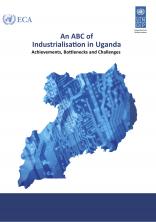An ABC of Industrialisation in Uganda: Achievements, Bottlenecks and Challenges

The development of the Ugandan economy is at a crossroads. While the country’s growth record over the last 30 years has been impressive, there is a pervasive feeling that the current paradigm is running out of steam. In 2016, Uganda registered the lowest rate of economic growth in the last 30 years. Income inequality has risen, and job creation has been lackluster. As a consequence, growth has not been sufficiently inclusive. This study argues that one of the main reasons for this situation is that the economy has been driven by the services sector, but at the expense of the industrial and manufacturing sectors. One of the consequences of the weak growth of the manufacturing sector is that it has made the economy more vulnerable and less resilient.
Industrial sector development is undoubtedly a key priority for the Ugandan government and occupies an integral part of its social and economic development plan, “Vision 2040”. President Museveni declared 2017 the “year of mass industrialisation”. But while government officials are keenly aware of the importance of industrial policy, the effective implementation of policy has been a major challenge.
Against this backdrop, this study provides an overview of the state of manufacturing in Uganda, and its contribution to the structural transformation of the economy towards higher value-added activities.